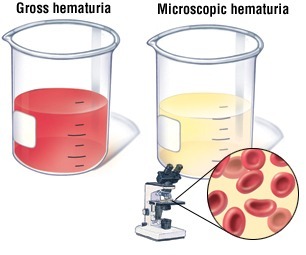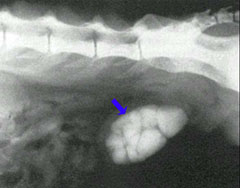If you’re like me, you don’t monitor every elimination your dog or cat makes. You don’t observe every urination. Yet at some point in a pet’s life, they will inevitably develop blood in their urine. This is a condition called hematuria. It’s actually pretty common, so I wanted to dedicate some time explaining this important medical issue. I hope you find the information useful and shareworthy. Happy reading!

Hematuria – What is it?
To understand hematuria, one should have an appreciation of basic urinary tract anatomy. The urinary tract starts with the kidneys, the organs that make urine. Urine then travels from the kidneys to the urinary bladder in small tubes called ureters. Urine is stored in the urinary bladder until an animal urinates. During urination, urine is expelled from the urinary bladder through a tube called the urethra to the outside world.

Hematuria simply means there are red blood cells in the urine. It’s a pretty straightforward definition. What isn’t always as straightforward is the cause of a pet’s hematuria. In fact, any of the urinary organs – kidneys, ureters, urinary bladder, urethra – could be the source of a pet’s hematuria. Furthermore, the genital tract is intimately associated with the urinary tract, so problems in the vagina and vestibule of females or the prostate and prepuce of males could also be a source of red blood cells in urine.
Regardless of organ involved, general processes that could cause red blood cells to appear in urine are:
- Infection (bacterial, parasitic, fungal)
- Inflammation
- Immune-mediated diseases
- Trauma
- Blood clotting abnormalities
- Cancer
Hematuria – What does it look like?
As blood is red, one might assume urine with red blood cells in them is similarly red in color. That’s true a majority of the time. But not always! In fact, sometimes only a microscopic amount of red blood cells is present, and thus urine appears grossly normal.

Often animals with hematuria have other clinical signs that can give the doctor important clues about which genitourinary organ is involved and what the underlying disease process is. Some of the important changes veterinarians look and about which they ask questions are:
- What is the volume of urine eliminated (e.g.: a normal volume vs. a larger/smaller volume)?
- What does your pet’s urine stream look like (strong and steady throughout vs. small spurts, etc.)?
- Does your pet need to urinate more frequently?
- Does your pet seem to strain when urinating?
- Does your pet leak urine while they’re walking?
- Does your pet leak urine while sleeping?
- Is the urine grossly abnormal?
- If the urine is grossly abnormal in color, is the urine abnormal during the entire urine stream or only at the beginning or end?
Please be prepared to answer these questions, as your input can be very helpful!
Hematuria – How is it diagnosed?
Of course, red colored is an obvious red flag for hematuria. However, not all reddish urine is caused by red blood cells in the urine. A simple, non-invasive urinalysis will help document the presence of red blood cells in urine, and thus confirm a finding of hematuria.
Once hematuria is documented, a veterinarian will continue a logical diagnostic process that will include blood and urine tests, as well as diagnostic imaging. Commonly recommended tests include:
- Complete blood count – to look for evidence of inflammation, anemia, and to measure platelets (initial clot-forming cells)
- Biochemical profile – to evaluate protein levels, electrolytes, and kidney values
- Urine culture – to document infection
- Coagulation testing – to check a pet’s ability to clot blood properly
- Abdominal imaging (i.e.: radiographs/x-rays +/- sonography) – to look for urinary stones and architectural changes in the urinary tract

Most cases of hematuria are straightforward. However, chronic hematuria can be troublesome and complicated. Pet parents may find it helpful to partner with a board-certified veterinary internal medicine specialist to develop a logical diagnostic plan.
Hematuria – How is it treated?
The specific way to treat hematuria depends on the underlying cause. A bacterial urinary tract infection is treated with an antibiotic. A coagulation disorder requires an infusion of a specific blood product called plasma and sometimes the administration of vitamin K1. Some urinary stones can be gradually dissolved with dietary manipulation over time while others need to be surgically removed. Tumors should be surgically removed whenever possible. Pet parents may find it helpful to partner with a board-certified veterinary internal medicine specialist to develop an appropriate treatment plan.
The take-away message about hematuria in dogs & cats…
Hematuria or red blood cells in the urine is a common problem encountered in feline and canine medicine. There are many possible causes, ranging from infections to infiltrative cancers. A logical and thorough diagnostic investigation is needed to ensure an accurate diagnosis is made and the most appropriate therapies are initiated.
To find a board-certified veterinary internal medicine specialist, please visit the American College of Veterinary Internal Medicine.
Wishing you wet-nosed kisses,





